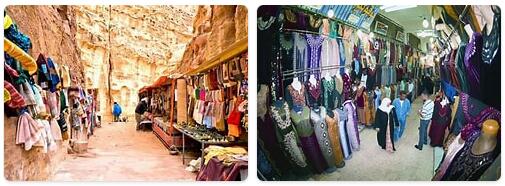Shopping in Jordan

A trip will never be complete if you don’t take some souvenirs home. Jordan is definitely a special place, with unique and interesting articles. Although not a conducive destination for shopping for electronics, local products are worth it. There is a wide variety of clothes, fabrics, rugs, spices, ceramics, jewelry and even antiques that need a place in your luggage!
Unlike many destinations around the world, believe me, the best place to guarantee your souvenirs is right inside the attractions. Whoever goes to Petra will find, even in the middle of the desert, the best cost / benefit when buying a souvenir from the country, be it a simple magnet or Bedouin costume. Most of the time, prices are on display, but negotiation is always welcome. Avoid paying more than due by reading about Money in Jordan. Check abbreviationfinder.org for abbreviations and acronyms related to Jordan.

JORDAN
With the Israeli occupation of the West Bank in June 1967 (the districts of alQuds, al-H̱alīl [Hebron] and Nābulus, which the government of ‘Ammān renounced on July 31, 1988), Jordan lost only 9 % of its total area, but at least a quarter of that which can be cultivated. The country, already almost completely devoid of natural resources, could not help but focus on the development of its human potential, providing skilled labor to neighboring Arab countries and laying the foundations for its transformation into an advanced base of technical assistance at the service of entire region: at the end of 1986, 276,000 emigrants in other Arab countries and 52,000 in non-Arab countries had to be added to the workforce active in Jordan Foreign workers in Jordan were instead 180,000, mostly Egyptians destined for low-handed jobs. There are approximately 850,000 Palestinian refugees in Jordan and 373,000 registered in the occupied West Bank.
The economy continued to develop, albeit with growing difficulties, thanks to remittances from emigrants and international aid: those provided by the USA (2.2 billion dollars from 1946 to 1983) were eclipsed after 1967 by those of the countries Arabs, who have granted a total sum seven times greater. However, a real collapse occurred between the end of 1990 and the first months of 1991, due to the embargo decreed by the United Nations against the ‘Irāq, after the invasion of Kuwait in August 1990, which deprived the Jordan of the fundamental resource represented by the transit trade and of a part of the emigrants’ remittances. The embargo and the conflict indirectly, but heavily, involved Jordan
The high rate of demographic increase (around 3.7% per year in the second half of the Eighties), which obliges Jordan to a growing dependence on food imports, makes the development of agriculture, which supplies above all cereals, fruit and vegetables. In addition to the irrigation systems already in operation along the Jordan Valley and the dams built on the Yarmūk, Zarqā ‘and Mūǧib rivers, new dams are planned on the Zarqā’ and Yarmūk (in partnership with Syria), while negotiations are underway with the ‘Irāq for the construction of an aqueduct of 650 km which should carry 5 m 3 / sec. of water of the Euphrates.
The mining sector (which already today sees Jordan in third place, after the USA and Morocco, in the world ranking for the export of phosphates, supplied above all to India and Yugoslavia) can count on reserves of over two billion tons of phosphates., forty billion tonnes of oil shale (whose exploitation, in collaboration with the USSR, began in 1983 with encouraging results), as well as on the potassium salts of the Dead Sea, the object of Arab-Islamic and Finnish investments. In 1987 and 1988 deposits of natural gas were identified in the north-eastern region (G.’s energy needs continue to be ensured by the supplies of hydrocarbons from Irāq and Saudi Arabia). Cement production fell below 2 million tonnes in 1989.
Economic development was hampered by the inadequacy of communication routes. The rail link between the al-Hasa phosphate fields and the port of al-‘Aqaba (financed by Germany) arrived in 1984 to transport three million tons; railway passengers are just about 30,000 per year, compared to more than a million passengers carried by airlines. The activity of the port of al-‘Aqaba developed in conjunction with the conflict between Iran and ‘Irāq, reaching 20 million tonnes of incoming and outgoing goods in 1989. New road links are being built between al-‘Aqaba and ‘Irāq.
The trade balance continues to be negative (about one and a half billion dollars in 1987).